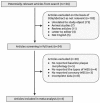The Relationship between Coronary Artery Wall Shear Strain and Plaque Morphology: A Systematic Review and Meta-Analysis
- PMID: 32046306
- PMCID: PMC7168174
- DOI: 10.3390/diagnostics10020091
The Relationship between Coronary Artery Wall Shear Strain and Plaque Morphology: A Systematic Review and Meta-Analysis
Abstract
Background and aim: Arterial wall shear strain (WSS) has been proposed to impact the features of atherosclerotic plaques. The aim of this meta-analysis was to assess the impact of different types of WSS on plaque features in coronary artery disease (CAD).
Methods: We systematically searched PubMed-Medline, EMBASE, Scopus, Google Scholar, and the Cochrane Central Registry, from 1989 up to January 2020 and selected clinical trials and observational studies which assessed the relationship between WSS, measured by intravascular ultrasound (IVUS), and plaque morphology in patients with CAD.
Results: In four studies, a total of 72 patients with 13,098 coronary artery segments were recruited, with mean age 57.5 ± 9.5 years. The pooled analysis showed that low WSS was associated with larger baseline lumen area (WMD 2.55 [1.34 to 3.76, p < 0.001]), smaller plaque area (WMD -1.16 [-1.84 to -0.49, p = 0.0007]), lower plaque burden (WMD -12.7 [-21.4 to -4.01, p = 0.04]), and lower necrotic core area (WMD -0.32 [-0.78 to 0.14, p = 0.04]). Low WSS also had smaller fibrous area (WMD -0.79 [-1.88 to 0.30, p = 0.02]) and smaller fibro-fatty area (WMD -0.22 [-0.57 to 0.13, p = 0.02]), compared with high WSS, but the dense calcium score was similar between the two groups (WMD -0.17 [-0.47 to 0.13, p = 0.26]). No differences were found between intermediate and high WSS.
Conclusions: High WSS is associated with signs of plaque instability such as higher necrotic core, higher calcium score, and higher plaque burden compared with low WSS. These findings highlight the role of IVUS in assessing plaque vulnerability.
Keywords: coronary artery disease; intravascular ultrasound; wall shear strain.
Conflict of interest statement
The authors have no conflict of interest to declare.
Figures




Similar articles
-
High Coronary Wall Shear Stress Worsens Plaque Vulnerability: A Systematic Review and Meta-Analysis.Angiology. 2021 Sep;72(8):706-714. doi: 10.1177/0003319721991722. Epub 2021 Feb 4. Angiology. 2021. PMID: 33535802 Free PMC article.
-
Combination of plaque burden, wall shear stress, and plaque phenotype has incremental value for prediction of coronary atherosclerotic plaque progression and vulnerability.Atherosclerosis. 2014 Feb;232(2):271-6. doi: 10.1016/j.atherosclerosis.2013.11.049. Epub 2013 Dec 1. Atherosclerosis. 2014. PMID: 24468138
-
Coronary artery wall shear stress is associated with progression and transformation of atherosclerotic plaque and arterial remodeling in patients with coronary artery disease.Circulation. 2011 Aug 16;124(7):779-88. doi: 10.1161/CIRCULATIONAHA.111.021824. Epub 2011 Jul 25. Circulation. 2011. PMID: 21788584 Clinical Trial.
-
Oscillatory wall shear stress is a dominant flow characteristic affecting lesion progression patterns and plaque vulnerability in patients with coronary artery disease.J R Soc Interface. 2017 Feb;14(127):20160972. doi: 10.1098/rsif.2016.0972. J R Soc Interface. 2017. PMID: 28148771 Free PMC article. Clinical Trial.
-
Meta-analysis and trial sequential analysis of ezetimibe for coronary atherosclerotic plaque compositions.Front Pharmacol. 2023 Mar 27;14:1166762. doi: 10.3389/fphar.2023.1166762. eCollection 2023. Front Pharmacol. 2023. PMID: 37050908 Free PMC article. Review.
Cited by
-
High Coronary Wall Shear Stress Worsens Plaque Vulnerability: A Systematic Review and Meta-Analysis.Angiology. 2021 Sep;72(8):706-714. doi: 10.1177/0003319721991722. Epub 2021 Feb 4. Angiology. 2021. PMID: 33535802 Free PMC article.
-
Disturbance of Mitochondrial Dynamics and Mitochondrial Therapies in Atherosclerosis.Life (Basel). 2021 Feb 20;11(2):165. doi: 10.3390/life11020165. Life (Basel). 2021. PMID: 33672784 Free PMC article. Review.
-
Mental Stress and Cardiovascular Health-Part I.J Clin Med. 2022 Jun 10;11(12):3353. doi: 10.3390/jcm11123353. J Clin Med. 2022. PMID: 35743423 Free PMC article. Review.
-
Novel imaging modalities for the identification of vulnerable plaques.Front Cardiovasc Med. 2024 Sep 12;11:1450252. doi: 10.3389/fcvm.2024.1450252. eCollection 2024. Front Cardiovasc Med. 2024. PMID: 39328242 Free PMC article. Review.
-
2'-5' oligoadenylate synthetase‑like 1 (OASL1) protects against atherosclerosis by maintaining endothelial nitric oxide synthase mRNA stability.Nat Commun. 2022 Nov 4;13(1):6647. doi: 10.1038/s41467-022-34433-z. Nat Commun. 2022. PMID: 36333342 Free PMC article.
References
-
- Mozaffarian D., Benjamin E.J., Go A.S., Arnett D.K., Blaha M.J., Cushman M., Das S.R., de Ferranti S., Despres J.P., Fullerton H.J. Heart Disease and Stroke Statistics-2016 Update: A Report From the American Heart Association. Circulation. 2016;133:e38. doi: 10.1161/CIR.0000000000000350. - DOI - PubMed
-
- Naghavi M., Libby P., Falk E., Casscells S.W., Litovsky S., Rumberger J., Badimon J.J., Stefanadis C., Moreno P., Pasterkamp G. From vulnerable plaque to vulnerable patient: A call for new definitions and risk assessment strategies: Part I. Circulation. 2003;108:1664–1672. doi: 10.1161/01.CIR.0000087480.94275.97. - DOI - PubMed
-
- Koskinas K.C., Feldman C.L., Chatzizisis Y.S., Coskun A.U., Jonas M., Maynard C., Baker A.B., Papafaklis M.I., Edelman E.R., Stone P.H. Natural history of experimental coronary atherosclerosis and vascular remodeling in relation to endothelial shear stress: A serial, in vivo intravascular ultrasound study. Circulation. 2010;121:2092–2101. doi: 10.1161/CIRCULATIONAHA.109.901678. - DOI - PMC - PubMed
LinkOut - more resources
Full Text Sources
Research Materials
Miscellaneous

